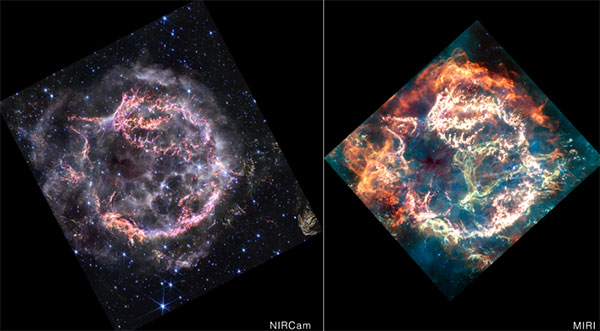NASA & SPACE NEWS

(NASA) – Like a shiny, round ornament ready to be placed in the perfect spot on a holiday tree, supernova remnant Cassiopeia A gleams in a new image from NASA’s James Webb Space Telescope.
As part of the 2023 Holidays at the White House, the First Lady of the United States Dr. Jill Biden debuted the first-ever White House Advent Calendar.
To showcase the “Magic, Wonder, and Joy” of the holiday season, Dr. Biden and NASA are celebrating with this new image from Webb.
While all is bright, this scene is no proverbial silent night. Webb’s NIRCam (Near-Infrared Camera) view of Cas A displays this stellar explosion at a resolution previously unreachable at these wavelengths. This high-resolution look unveils intricate details of the expanding shell of material slamming into the gas shed by the star before it exploded.
Cas A is one of the most well-studied supernova remnants in all of the cosmos.
Over the years, ground-based and space-based observatories, including NASA’s Chandra X-Ray Observatory, Hubble Space Telescope, and retired Spitzer Space Telescope have assembled a multiwavelength picture of the object’s remnant.
However, astronomers have now entered a new era in the study of Cas A.
In April 2023, Webb’s MIRI (Mid-Infrared Instrument) started this chapter, revealing new and unexpected features within the inner shell of the supernova remnant. Many of those features are invisible in the new NIRCam image, and astronomers are investigating why.
Infrared light is invisible to our eyes, so image processors and scientists translate these wavelengths of light into visible colors. In this newest image of Cas A, colors were assigned to different filters from NIRCam, and each of those colors hints at different activities occurring within the object.
At first glance, the NIRCam image may appear less colorful than the MIRI image. However, this simply comes down to the wavelengths in which the material from the object is emitting its light.
The most noticeable colors in Webb’s newest image are clumps represented in bright orange and light pink that make up the inner shell of the supernova remnant. Webb’s razor-sharp view can detect the tiniest knots of gas, comprised of sulfur, oxygen, argon, and neon from the star itself.
Embedded in this gas is a mixture of dust and molecules, which will eventually become components of new stars and planetary systems. Some filaments of debris are too tiny to be resolved by even Webb, meaning they are comparable to or less than 10 billion miles across (around 100 astronomical units). In comparison, the entirety of Cas A spans 10 light-years across or 60 trillion miles.
“With NIRCam’s resolution, we can now see how the dying star absolutely shattered when it exploded, leaving filaments akin to tiny shards of glass behind,” said Danny Milisavljevic of Purdue University, who leads the research team.
“It’s really unbelievable after all these years studying Cas A to now resolve those details, which are providing us with transformational insight into how this star exploded.”

When comparing Webb’s new near-infrared view of Cas A with the mid-infrared view, its inner cavity and outermost shell are curiously devoid of color.
The outskirts of the main inner shell, which appeared as a deep orange and red in the MIRI image, now look like smoke from a campfire. This marks where the supernova blast wave is ramming into surrounding circumstellar material. The dust in the circumstellar material is too cool to be detected directly at near-infrared wavelengths, but lights up in the mid-infrared.
Researchers say the white color is light from synchrotron radiation, which is emitted across the electromagnetic spectrum, including the near-infrared. It’s generated by charged particles traveling at extremely high speeds spiraling around magnetic field lines. Synchrotron radiation is also visible in the bubble-like shells in the lower half of the inner cavity.
Also not seen in the near-infrared view is the loop of green light in the central cavity of Cas A that glowed in mid-infrared, nicknamed the Green Monster by the research team. This feature was described as “challenging to understand” by researchers at the time of their first look.
While the ‘green’ of the Green Monster is not visible in NIRCam, what’s left over in the near-infrared in that region can provide insight into the mysterious feature. The circular holes visible in the MIRI image are faintly outlined in white and purple emission in the NIRCam image – this represents ionized gas. Researchers believe this is due to the supernova debris pushing through and sculpting gas left behind by the star before it exploded.
CLICK HERE FOR BREVARD COUNTY NEWS
The post PHOTO OF THE DAY: NASA’s James Webb Telescope Stuns With High-Definition Look at Exploded Star appeared first on Space Coast Daily.

